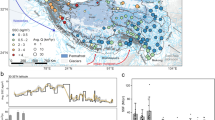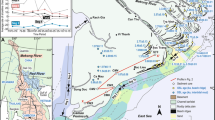Abstract
It is generally supposed that specific sediment yield—the quantity of sediment passing a monitored river cross-section per unit area drained upstream of that section—declines as the area drained increases1–3. Part of the sediment mobilized from the land surface is supposed to go back into storage at field edges, and on footslopes and floodplains. In contrast, we show here that data from British Columbian rivers reveal a pattern of increasing specific sediment yield at all spatial scales up to 3 × 104 km2. This results from the dominance of secondary remobilization of Quaternary sediments along river valleys over primary denudation of the land surface. The result controverts the conventional model which has been derived from studies of small, highly disturbed agricultural catch-ments. The rivers are still responding to the last glaciation, giving a landscape relaxation time greater than 10 kyr. This holds pro-found implications for geomorphological theory and for studies of erosion.
This is a preview of subscription content, access via your institution
Access options
Subscribe to this journal
Receive 51 print issues and online access
$199.00 per year
only $3.90 per issue
Buy this article
- Purchase on Springer Link
- Instant access to full article PDF
Prices may be subject to local taxes which are calculated during checkout
Similar content being viewed by others
References
Am. Soc. civil Engng Sedimentation Engineering Manuals and Reps on Engng Practice 54, 458 (1975).
Walling, D. E. J. Hydrology 65, 209–237 (1983).
Chorley, R. J., Schumm, S. A. & Sugden, D. E. Geomorphology 53 and 326 (Methuen, London, 1984).
Happ, S. C., Rittenhouse, G. & Dobson, G. C. U.S. Dept agric. Tech. Bull. 695 (1940).
Meade, R. H. & Trimble, S. W. Int. Ass. Sci. Hydrol. Publs 113, 99–104 (1974).
Costa, J. E. Bull. geol. Soc. Am. 86, 1281–1286 (1975).
Schumm, S. A. The Fluvial System (Wiley, New York, 1978).
Meade, R. H. J. Geol. 90, 235–252 (1982).
Slaymaker, O. in International Geomorphology 1986 Part I (ed. Gardiner, V.) 925–945 (Wiley, Chichester, 1987).
Church, M., Kellerhals, R. & Day, T. J. Can. J. Earth Sci. (in the press).
McLean, D. G. & Church, M. A reanalysis of sediment transport observations in lower Fraser River Environment Canada, Inland Waters Dir., Rep. IWD-HQ-WRB-SS-86-2 (1986).
Weirich, F. H. Geografiska Ann. 67A, 83–99 (1985).
Slaymaker, O. Int. Ass. Sci. Hydrol. Publs 122, 109–117 (1977).
Hickin, E. J. & Nanson, G. C. 1984. J. hydraulic Engng 110, 1557–1567 (1984).
Nanson, G. C. & Hickin, E. J. Bull. geol. Soc. Am. 97, 497–504 (1986).
Ashmore, P. E. Suspended sediment transport in the Saskatchewan River basin Environment Canada, Inland Waters Dir., Rep. IWD-HQ-WRB-SS-86-9 (1986).
Church, M. & Ryder, J. M. Bull. geol. Soc. Am. 83, 3059–3072 (1972).
Strahler, A. H. Am. J. Sci. 248, 673–696 (1950).
Hack, J. T. Am. J. Sci. 258A, 80–97 (1960).
Trimble, S. W. Science 188, 1207–1208 (1975).
Nanson, G. C. thesis, Simon Fraser Univ., Vancouver (1977).
Author information
Authors and Affiliations
Rights and permissions
About this article
Cite this article
Church, M., Slaymaker, O. Disequilibrium of Holocene sediment yield in glaciated British Columbia. Nature 337, 452–454 (1989). https://doi.org/10.1038/337452a0
Received:
Accepted:
Issue Date:
DOI: https://doi.org/10.1038/337452a0
This article is cited by
-
Warming-driven erosion and sediment transport in cold regions
Nature Reviews Earth & Environment (2022)
Comments
By submitting a comment you agree to abide by our Terms and Community Guidelines. If you find something abusive or that does not comply with our terms or guidelines please flag it as inappropriate.



